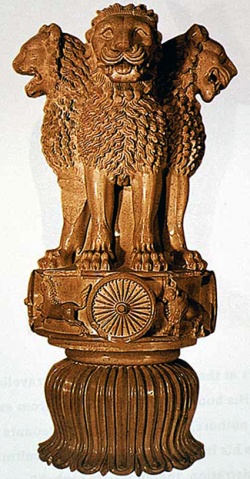National Emblem of India: The Four Lions of Sarnath
To the newbie Indian tourist, reading that the “National Emblem of India is an adapted version of the Lion Capital of Maurya king Ashoka at Sarnath” means virtually nothing. So let’s break down the historical background to better understand the beautiful symbol of incredible India.
King Ashoka of Sarnath
Near Varanasi, Uttar Pradesh, lies the small town of Sarnath. The Maurya king Ashoka reigned in this northern part of India during the 3rd century B.C. It was here that Ashoka built the Sarnath pillar to commemorate the site of the first preaching of Lord Buddha where at he taught the Dharma to five monks. This pillar is just one of many erected by Ashoka to convey the tenets of Buddhism. But the Sarnath pillar was crowned with a unique sculpture known as the Lion Capital.
What is the Lion Capital of Sarnath?
The Ashoka Lion Capital of Sarnath comprises four lions, standing back to back, mounted on a cylindrical abacus. The abacus features the sculptures of an elephant, a galloping horse, a bull, and a lion, separated by intervening 24-spoked Dharma wheels over an inverted bell-shaped lotus flower (National Flower of India).
The four animals in the Lion Capital are believed to symbolize different phases in Lord Buddha’s life. The Elephant is a representation of Queen Maya’s conception of Buddha when she saw a white elephant entering her womb in a dream. The Bull represents desire during the life of the Buddha as a prince. The Horse symbolizes Buddha’s departure from palatial life. The Lion represents the attainment of Nirvana by Lord Buddha.
There are also non-religious symbolic interpretations of the Lion Capital believing the four lions symbolize Ashoka’s rule over the four directions, the wheels as symbols of his enlightened rule and the four animals as symbols of four adjoining territories of India.
The Sarnath pillar still stands in it’s original place, however the Ashoka Lion Capital has been moved to the Sarnath Museum for preservation.
Present Day National Emblem of India
We can now better understand what it means to read that the National emblem of India is an adapted version of the Lion Capital of Ashoka at Sarnath. In the State emblem, adopted by the Government of India on January 26, 1950, only three lions are visible, the fourth being hidden from view. Symbolizing power, courage and confidence, the abacus is girded by four smaller animals regarded as guardians of the four directions; The lion of the North, the elephant of the East, the horse of the South and the bull of the West. Each of these animals is separated by intervening wheels of Dharma Chakras* (Eternal wheels of law). The inverted bell-shaped lotus which the original sculpture shows the abacus resting on has been omitted.
Usually inscribed below the abacus in Devanagari script is the motto Satyameva Jayate meaning “Truth Alone Triumphs”. This is a quote from Mundaka Upanishad, the concluding part of the sacred Hindu Vedas. On the original Sarnath pillar, an inscription of one of the Edicts of Ashoka reads, “No one shall cause division in the order of monks”.
The national emblem was chosen as a symbol of contemporary India’s reaffirmation of it’s ancient commitment to world peace and goodwill.
- Readers of Full Stop India’s Hinduism 101 may recall the chakra as a recognizable symbol of the Hindu god Vishnu. The disc like weapon known as a general symbol for protection is almost always depicted in images of Vishnu, the God of Preservation.
In Sight
Tourists will undoubtedly view this national insignia countless times during their travels of India. The Lion Capital is visible on Indian Currency as well as national passports, government buildings, and the official seal of the Central and State governments.

